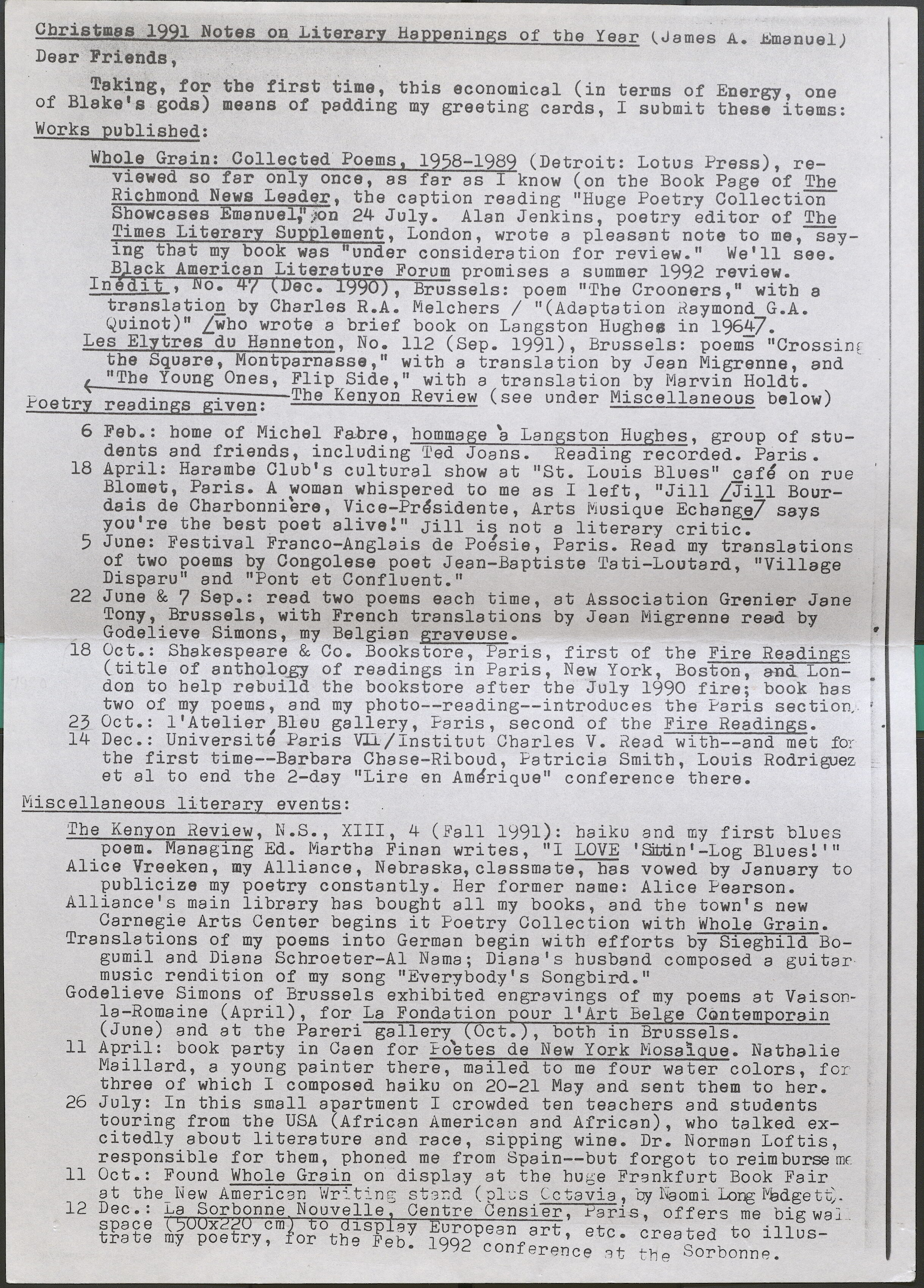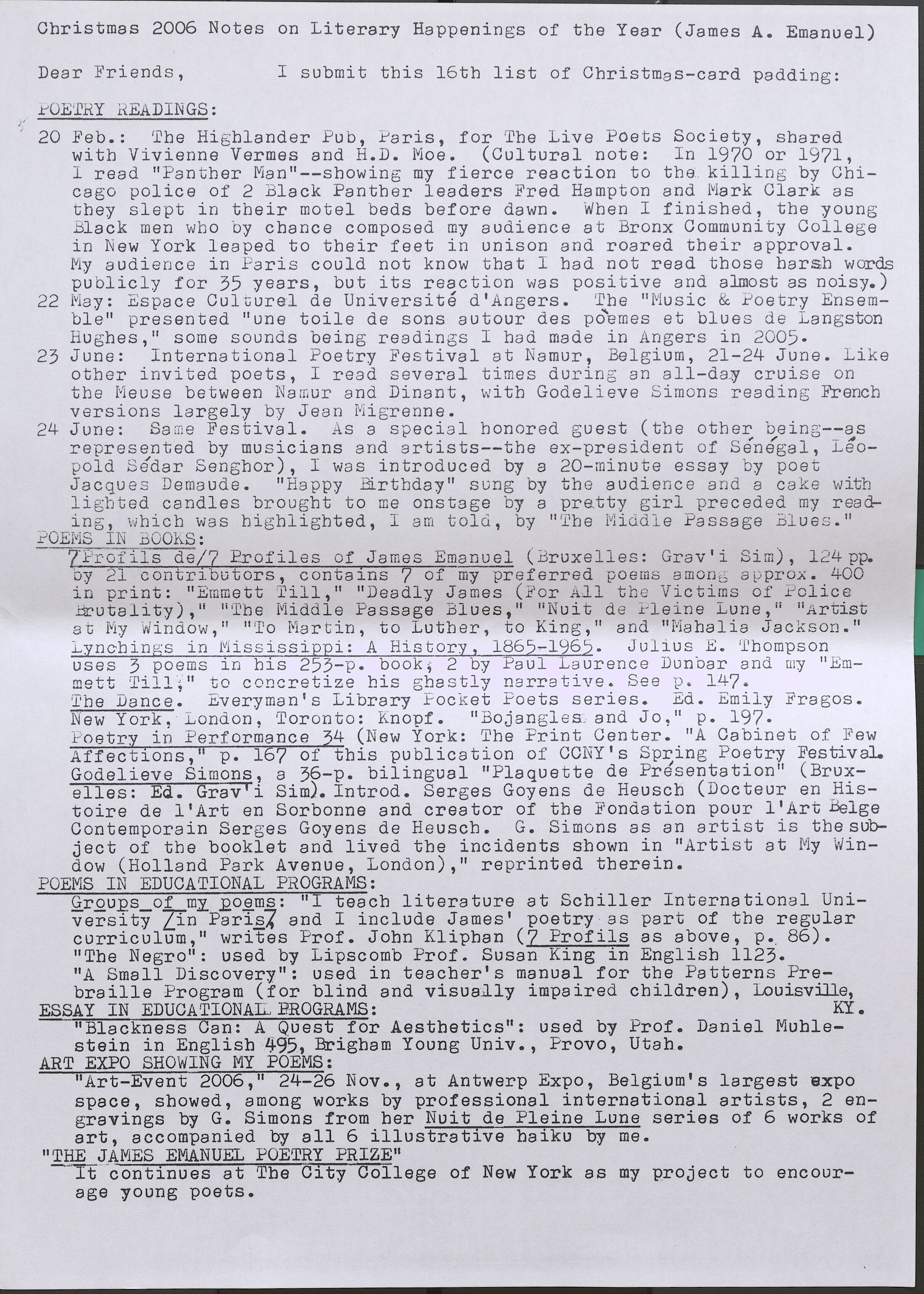“Emanuel's Christmas Cards and Christmas Notes”
From 1991 to 2006, James A. Emanuel included in his Christmas cards “Notes on Literary Happenings of the Year” also called his “Christmas padding.” Written economically, in the style of a curriculum vitae, Emanuel listed his activities by type such as poetry readings, books, articles, exhibits, and other categories. His “Christmas Notes” are a page long with the exception of the year 2000; that year his note was nearly a page and half. Depending on the type of literary happening, Emanuel would include dates, places, collaborators and sometimes even a brief quote from a correspondence. Emanuel sent these notes to family members, friends, and colleagues. Occasionally, he would include a written annotation on the note if he wanted to address it to someone in particular instead of using the general salutation “friends.”

Figure 1. Christmas 1991 Notes on Literary Happenings.
I am not certain why the “Christmas Notes” began in 1991, but there are circumstances that illuminate the importance of this correspondence. For one, the notes were important for maintaining a connection with friends and family who were abroad once he had made his home in France. The Emanuel family recordings show the importance of physical presence and keeping in touch with each other. When Emanuel left the United States to retire in Paris in 1984 (after the death of his son, James Jr.), he came back to the USA briefly in 1986 for his mother’s funeral, but after that, he never returned. His first “Christmas Notes” are written five years later. Second, Emanuel’s “Christmas Notes” highlight his activities as a poet since his “role as a scholar [was] substantially over” (Emanuel “Letter to Douglas Watson” 2). Connected to this, the first “Christmas Notes” promoted Emanuel’s new book of poetry Whole Grain: Collected Poems 1958-1989, which contained 215 poems and a workflow that Emanuel called “once-in-a-lifetime labor” (Emanuel Preface 10). Third, the Christmas show Emanuel’s growing collaborations. In Michel Fabre book From Harlem to Paris: 1840 to 1980, which was also published in 1991, Fabre noted that Emanuel was reclusive, and he kept a small group of friends (Fabre 330). However, Emanuel’s circle began to widen a little in the late 1980s as demonstrated by his collaboration with Nicole Lamotte and Keith O. Anderson in the publication Deadly James and Other Poems (1987). The “Christmas Notes” are evidence of Emanuel widening his circle, which becomes apparent in this analysis.
Just as Emanuel’s decision to start writing the “Christmas Notes” is unexplained so is his decision to stop writing the notes after 16 years. He does not state in his 2006 “Christmas Notes” that it would be his last. And while there was a steady decline in activities during the last five years of writing his notes (2001-2006), it appears that Emanuel had found his people and streamlined the events he knew he wanted to do and sought to do those as an annual tradition. Also, we must consider the fact that Emanuel was eighty-five-years old when he finished his final “Christmas Note” in 2006. Maybe since this padding was written in curriculum-vitae style and looked similar to an annual report, he felt that he could finally retire from documenting his activities in this way.

Figure 2. Christmas 2006 Notes on Literary Happenings.
Emanuel’s “Christmas Notes” are revelatory. While writing my dissertation chapter on Emanuel, I thought that his relocation to France put him at a geographical disadvantage in terms of his reach. However, his “Christmas Notes” contradict my initial analysis. For instance, Emanuel’s notes show that his reach in the classroom is significant in its own right. Hundreds of students in Professor Janet Hulstrand’s Hunter College study abroad program “Paris Through the Eyes of Travelers” were exposed to his poetry for several years. Also, according to Emanuel’s “Christmas Notes” his works were also taught by Professors John Kliphan, Susan King, Daniel Muhlestein, Victoria Chevalier, Anne Luyat, and Norman Loftis. Between 1991 and 2006, students taught by these professors read Emanuel’s work and/or heard Emanuel read his work in person. This does not include the professors who assigned his work without making him aware of it. In fact, if it was not for Emanuel’s impact and reach in the classroom, I would not have had the benefit of being a scholar of his work. It was in Professor Janis Mayes’s Syracuse University Abroad’s program “Paris Noir: Literature, Art and Contemporary Life in Diaspora” that I exposed to Emanuel’s work.
Works Cited
Emanuel, James A. “Letter to Douglas Watson, December 1981 (page 2 of 3).” MS Box 4, Folder 7, “Watson, Douglas, 1981 – 1993,” James A. Emanuel papers, 1922 - 2018. Library of Congress. Washington, D.C.
Emanuel, James A. Preface. Whole Grain: Collected Poems, 1958–1989, Lotus Press, 1991, p. 10.